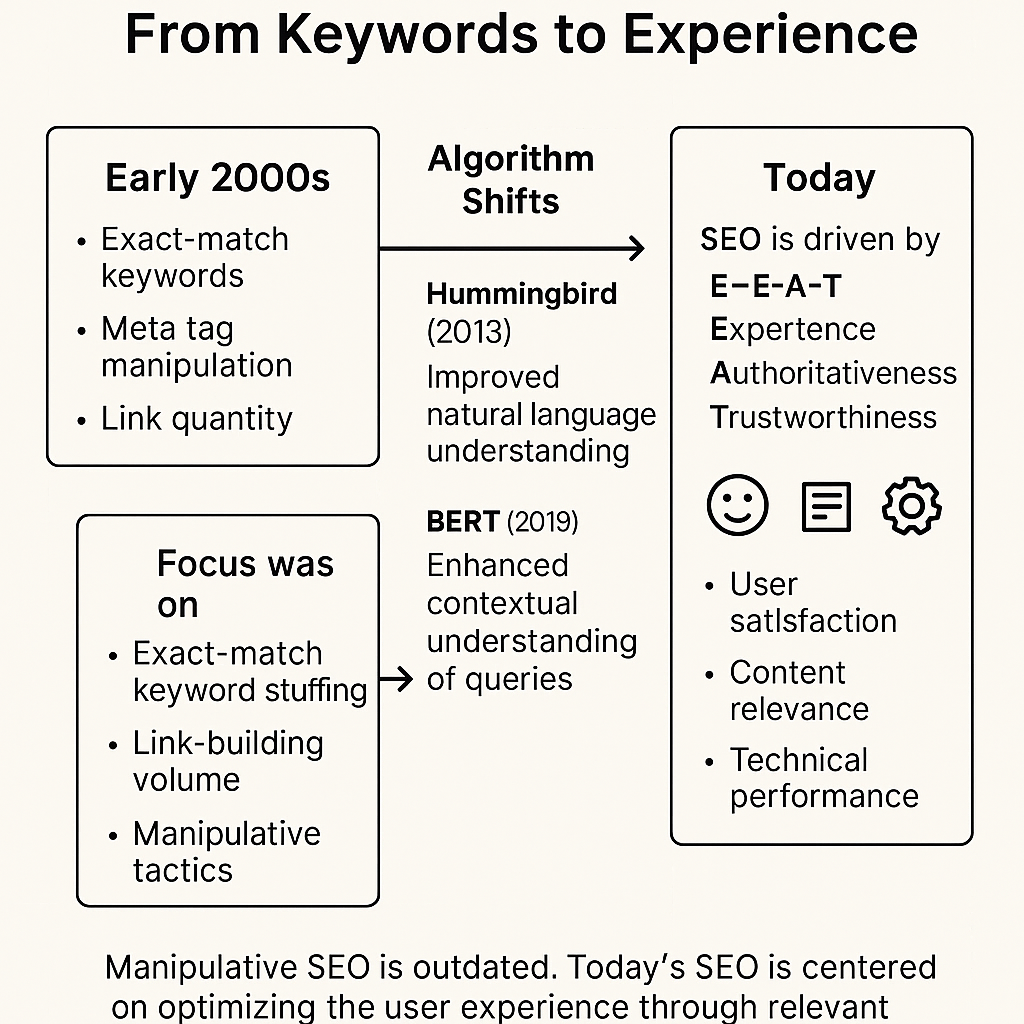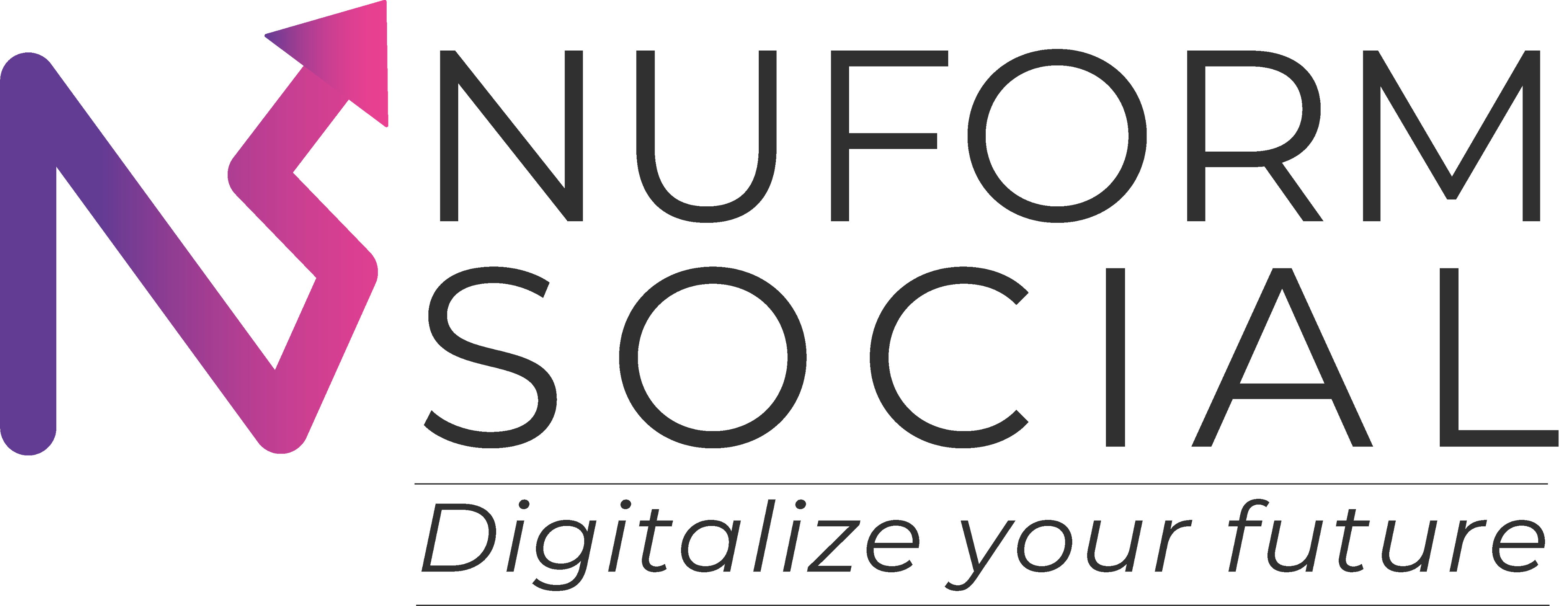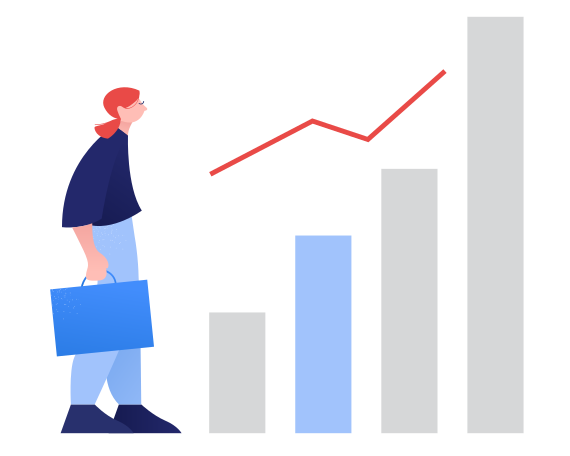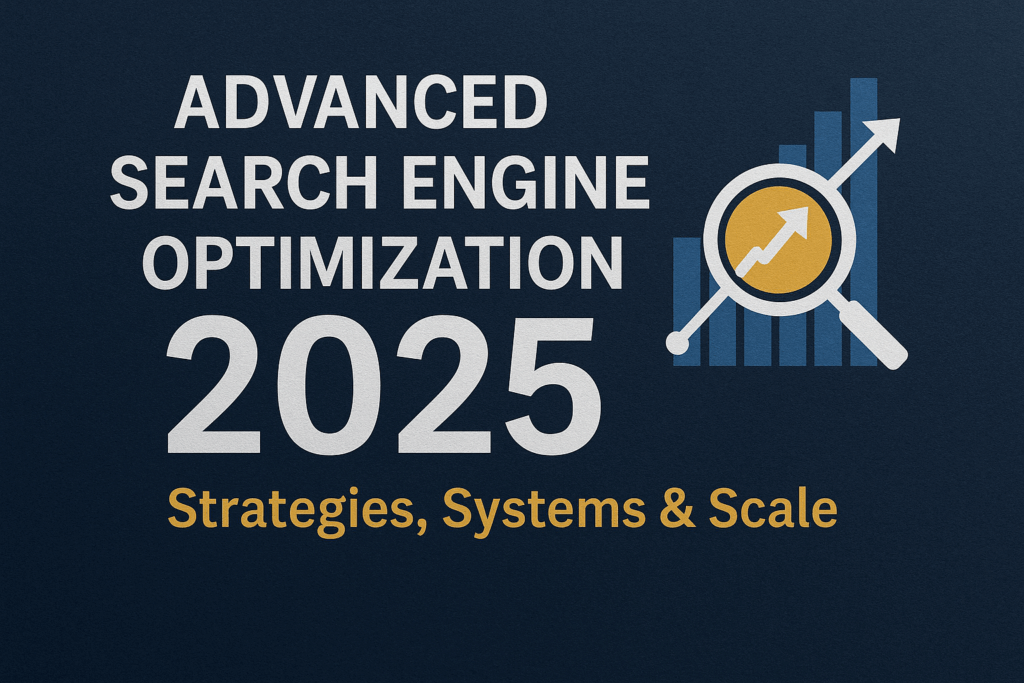Advanced Search Engine Optimization 2025: Strategies, Systems & Scale
In 2025, advanced SEO will go beyond traditional keyword optimization to prioritize user experience, AI-driven insights, and strategic content creation. Marketers focus on understanding and optimizing for search intent, ensuring content aligns with what users are truly searching for. AI-powered tools help automate tasks like keyword research, content analysis, and trend prediction, enabling smarter SEO strategies. Additionally, staying adaptable to ever-evolving search algorithms ensures that websites remain visible and relevant. A holistic approach that integrates technical SEO, content optimization, and user-centric design will drive success in the competitive digital landscape of 2025.
The Evolution of SEO: From Keywords to Experience

The SEO landscape has undergone a massive transformation, shifting from tactical keyword stuffing to a sophisticated, user-centric discipline driven by context, credibility, and experience. In the early 2000s, SEO was dominated by exact-match keywords, meta tag manipulation, and link quantity. But with the rise of semantic search and natural language processing, search engines have become far more intelligent in understanding meaning, not just matching words.
Google’s major algorithm updates have catalyzed this shift. Hummingbird (2013) introduced contextual search, focusing on phrase intent rather than keyword frequency. BERT (2019) pushed this further with deep learning models that interpret natural language, improving how Google understands nuanced queries. Most recently, the Helpful Content Update (2022) emphasized experience-driven content that delivers genuine value to users.
Today, successful SEO strategies are built on the foundation of E-E-A-T (Experience, Expertise, Authoritativeness, Trustworthiness). Search engines prioritize sites that demonstrate credibility and align with user needs. AI and machine learning are now core components of ranking logic, rewarding structured content, topic authority, and technical excellence.
This evolution marks the end of manipulative SEO and the rise of experience optimization, where user satisfaction, content relevance, and technical performance intersect to drive sustainable visibility.
Here’s a more detailed look at the key aspects of advanced SEO in 2025:
Shift to User-Centric SEO
SEO today is no longer just about stuffing keywords into content. Search engines have become smarter, and they now focus more on what users want. That’s why it’s important to shift to user-centric SEO—a strategy that puts the needs of users first.
1. Understand Search Intent
Instead of focusing only on keywords, think about why someone is searching. Are they looking for information? Do they want to buy something? Or are they comparing options? Creating content that matches these different search goals helps you connect better with your audience. When your content matches their intent, they’re more likely to stay on your site and take action.
2. Create Question-Based Content
Many people now search by asking questions—especially with voice search. That means your content should aim to answer those questions. For example, if someone asks “How to choose the best laptop?”, your content should provide a clear, helpful answer. Even if your content doesn’t have the exact keyword, answering the user’s question builds trust and can help your site appear in featured snippets on Google.
3. Track User Engagement
To know if your content is working, look at how people interact with it. Are they spending time on the page? Are they scrolling through the content or leaving quickly? Key metrics like time on the page, bounce rate, and scroll depth show how users behave. If people are leaving quickly, your content may not be useful. If they stay and read more, that’s a good sign.
Modern SEO is about helping people. When you understand what users want and give them useful, relevant information, search engines reward you with better rankings and more traffic. Focus on people first, and the results will follow.
AI-Driven SEO: Unlocking Hyper-Intelligence for Smarter Search Strategies
1. Hyper-Intelligence SEO: Predictive Optimization at Scale
Advanced Search Engine Optimization is evolving rapidly with the integration of AI and machine learning. Hyper-intelligent SEO practices now allow businesses to analyze user behaviour, understand search intent, and predict content trends with precision. By using AI algorithms, marketers can optimize content proactively, aligning with user needs before demand spikes. This data-driven approach ensures that advanced Search Engine Optimization is always a step ahead of changing search patterns.
2. AI-Powered Tools: Smarter Keyword Research and Automation
The foundation of advanced Search Engine Optimization lies in powerful AI-driven tools. Platforms like SurferSEO, SEMrush, and Ahrefs help automate critical SEO tasks, including keyword research, content performance analysis, and link-building strategies. These tools use artificial intelligence to provide insights that enhance content relevance and keyword placement. Leveraging such tools enables businesses to execute advanced Search Engine Optimization more efficiently, achieving higher rankings and better ROI through automated, data-backed decisions
3. Adapting to Algorithm Changes: Staying Aligned with AI in Search
To maintain the effectiveness of advanced Search Engine Optimization, adapting to search engine algorithm updates is crucial. Google’s use of AI technologies like BERT, MUM, and Gemini has changed how search results are delivered. These updates prioritize understanding context, user intent, and semantic relevance. Staying informed about such advancements allows businesses to refine their advanced Search Engine Optimization strategies continually, ensuring alignment with evolving search standards and maximizing visibility.
By incorporating hyper-intelligent SEO strategies, AI-powered tools, and agile adaptation to algorithm changes, businesses can harness the full potential of advanced Search Engine Optimization to stay competitive in the digital space.
Strategic Content Creation: Building Authority and Enhancing SEO Performance
1. Topic Clusters: Structuring Content Around Core Themes
One of the most effective strategies in advanced Search Engine Optimization is the use of topic clusters. This approach involves creating a series of interlinked articles or pages that revolve around a central theme. Each piece of content targets specific subtopics while linking back to a core “pillar” page. This internal linking structure not only improves website navigation but also signals content depth and relevance to search engines. Topic clusters enhance user experience by guiding visitors through related information seamlessly, which is essential for successful advanced Search Engine Optimization.
2. Content Hubs: Centralizing Value and Authority
Content hubs are comprehensive, central pages that serve as authoritative resources on a particular subject. These hubs aggregate and organize related content in one place, helping users access all relevant information without jumping across multiple sites. From an advanced Search Engine Optimization standpoint, content hubs strengthen topical authority, improve dwell time, and boost the likelihood of earning backlinks. They also provide a strategic anchor for linking multiple topic cluster pages, reinforcing the overall content architecture.
3. Content Optimization: Balancing Search Intent and Readability
Advanced Search Engine Optimization goes beyond just including keywords; it’s about creating content that satisfies both search engines and real users. Optimizing content involves refining headlines, improving readability, using relevant visuals, and ensuring mobile-friendliness. Structured data, meta tags, and internal links further enhance visibility in search results. Equally important is ensuring that the content answers user queries clearly and concisely, keeping engagement high and bounce rates low.
By applying these strategic content creation practices, businesses can build stronger content ecosystems that support advanced Search Engine Optimization, drive traffic, and establish lasting online authority.
Technical SEO & Site Structure: Strengthening the Foundation of Advanced Search Engine Optimization
1. Site Architecture: Streamlined Structure for Better Indexing
A well-structured website is crucial for effective advanced Search Engine Optimization. Optimizing site architecture means organizing pages into logical directories and using clean, descriptive URLs. Grouping similar content under thematic sections not only helps users navigate easily but also assists search engine crawlers in understanding and indexing your content efficiently. A hierarchical structure with strategic internal linking enhances crawlability, making it easier for search engines to rank your pages appropriately.
2. Core Web Vitals: Enhancing Performance and User Experience
Advanced Search Engine Optimization now heavily emphasizes user experience, with Core Web Vitals playing a key role. These metrics—Largest Contentful Paint (LCP), Cumulative Layout Shift (CLS), and First Input Delay (FID)—measure loading speed, visual stability, and interactivity. To improve these scores, optimize images, reduce server response times, and minimize layout shifts. Websites that meet Google’s Core Web Vitals standards not only rank higher but also provide a smoother, faster experience that keeps users engaged.
3. Mobile-First Indexing: Optimizing for the Mobile Experience
With the majority of searches now happening on mobile devices, mobile-first indexing has become a critical aspect of advanced Search Engine Optimization. Google primarily uses the mobile version of a site for indexing and ranking, so it’s essential that your site is fully responsive and mobile-friendly. This includes readable text, touch-friendly buttons, and fast loading times on all devices. A seamless mobile experience not only supports better rankings but also aligns with user expectations in today’s mobile-centric digital landscape.
By focusing on technical SEO elements like structured site architecture, Core Web Vitals, and mobile-first optimization, businesses can build a robust foundation for advanced Search Engine Optimization and long-term digital success.
Link Building & Authority: Elevating Online Presence through Advanced Search Engine Optimization
1. Leverage Unlinked Mentions: Turn Brand Mentions into Backlinks
One of the easiest and most overlooked strategies in advanced Search Engine Optimization is identifying unlinked brand mentions. These are instances where your brand is mentioned online without a backlink. By reaching out to the site owners or content creators, you can request that the mention be turned into a clickable link. This approach is efficient, low-risk, and can quickly boost your backlink profile—an essential factor in improving domain authority and search engine rankings.
2. Build Backlinks from Podcasts: Tap into a Niche Authority Source
Podcasts are an emerging and valuable channel for building backlinks in advanced Search Engine Optimization. Appearing as a guest on relevant industry podcasts not only helps establish thought leadership but also provides opportunities for earning backlinks through show notes, episode descriptions, and related content pages. These links often come from authoritative domains, making them powerful for boosting SEO performance and visibility within your niche.
3. Build a Content Alliance: Collaborate for Mutual Growth
Forming content alliances with other websites, influencers, or industry leaders is a strategic method for link building under the umbrella of advanced Search Engine Optimization. This could involve guest blogging, co-authoring content, or cross-promoting each other’s work. Such partnerships help in acquiring high-quality backlinks, expanding your reach, and increasing brand visibility. When executed effectively, content alliances create a win-win situation that drives traffic and enhances authority across both audiences.
Incorporating these link-building techniques as part of an advanced Search Engine Optimization strategy helps strengthen domain authority, improve SERP rankings, and generate sustainable organic traffic.
Local SEO: Driving Regional Visibility with Advanced Search Engine Optimization
1. Google My Business Optimization: Strengthen Your Local Presence
A fully optimized Google My Business (GMB) profile is a cornerstone of advanced Search Engine Optimization for local visibility. Ensure that your GMB listing includes accurate business details—such as name, address, phone number (NAP), business hours, and categories. Upload high-quality images, regularly update posts, and utilize features like Q&A and services to improve engagement. A well-maintained GMB profile increases your chances of appearing in the local 3-pack and enhances trust with potential customers.
2. Local Keyword Research: Targeting Community-Centric Search Intent
Advanced Search Engine Optimization at the local level requires a sharp focus on localized keyword targeting. Conduct keyword research specific to your geographic area, including city, neighbourhood, and regional modifiers. Identify terms that reflect local search intent, such as “best dentist in Noida” or “24/7 plumbing services near me.” Optimizing your website and content with these keywords improves your chances of showing up in local search results and attracting nearby customers actively seeking your services.
3. Reviews and Ratings: Build Social Proof and Improve Local Rankings
Customer reviews play a critical role in both reputation management and advanced Search Engine Optimization. Encourage satisfied customers to leave positive reviews on your Google My Business profile and other local directories like Yelp, Justdial, and Trustpilot. Responding to reviews—both positive and negative—demonstrates your commitment to customer satisfaction and signals trustworthiness to search engines. More positive reviews can boost your local search rankings and influence potential customers’ purchasing decisions.
By implementing these local SEO strategies, businesses can strengthen their advanced Search Engine Optimization efforts, dominate local search results, and attract high-intent local traffic that converts.
Monitoring and Analytics: Data-Driven Decisions for Advanced Search Engine Optimization
1. Google Search Console: Optimize Performance Through Search Insights
Google Search Console is an essential tool for advanced Search Engine Optimization. It provides valuable insights into how your website performs in search results, including data on impressions, clicks, average position, and CTR. You can identify which queries drive the most traffic, uncover indexing issues, and monitor core web vitals. Regularly reviewing Search Console allows you to address technical SEO issues, enhance keyword targeting, and ensure your site is being crawled and indexed effectively.
2. Google Analytics: Understand User Behavior and Content Performance
Google Analytics offers a deep dive into how users interact with your website—critical for refining your advanced Search Engine Optimization strategy. By analyzing metrics such as bounce rate, average session duration, page views, and conversion paths, you can identify which content performs well and where users drop off. Understanding user behaviour enables you to optimize content, improve site structure, and enhance the overall user experience, leading to better rankings and higher engagement.
3. Platform-Specific Visibility Report Card: Expand and Optimize Multi-Platform Presence
For businesses operating across multiple digital platforms, monitoring visibility isn’t limited to Google. A platform-specific visibility report card allows you to assess performance on channels like YouTube, TikTok, Amazon, or even social media. Tracking views, engagement rates, keyword performance, and audience demographics on each platform helps you identify content gaps and opportunities. This comprehensive approach to advanced Search Engine Optimization ensures your brand maintains a strong and consistent presence across all relevant digital touchpoints.
By leveraging these tools and insights, businesses can make informed, data-driven decisions to continuously improve and scale their advanced Search Engine Optimization efforts.
Case Study: Scaling SEO for a SaaS Enterprise
Initial Audit Findings and Gaps:
A mid-sized B2B SaaS enterprise approached us with stagnant organic growth despite a well-designed product. Our comprehensive SEO audit using Screaming Frog and Google Search Console revealed several critical issues: fragmented content with no clear topical clusters, poor internal linking, crawl budget waste due to orphan pages, and slow-loading core web vitals. Additionally, less than 40% of the blog content was indexed, and keyword cannibalization was impacting over 15 high-priority pages.
Strategy Implemented:
We deployed a 3-tiered strategy:
- Content Clustering: Grouped blog posts and feature pages into thematic clusters targeting high-intent, mid-funnel keywords. A new pillar-page structure was introduced to improve topical relevance and reduce cannibalization.
- Technical Fixes: Used Python scripts and Screaming Frog to automate crawl error detection, remove duplicate content, optimize site speed, and enforce schema markup across the platform.
- Link Strategy: Built an internal linking framework using automation, directing authority toward key product and comparison pages. Simultaneously, we launched a targeted backlink outreach campaign focused on high-authority SaaS directories and guest posting.
Results (Over 6 Months):
- Organic traffic increased by 148%
- Page 1 keyword rankings improved by 93%
- Conversions from organic rose by 62%
- Indexed pages grew by 71%, with the bounce rate dropping by 28%
This case demonstrates how structured SEO scaling, rooted in both automation and strategic content design, can rapidly accelerate growth for SaaS platforms.
Expert FAQs on Advanced SEO
Q1: How do I prioritize SEO tasks when resources are limited?
Start with high-impact, low-effort tasks. Prioritize technical fixes that affect crawlability and indexation (e.g., broken links, duplicate content), then move to on-page optimizations like meta tags and internal linking. Use the 80/20 rule—focus on the 20% of pages driving 80% of traffic. Tools like Screaming Frog, Google Search Console, and Ahrefs can help you triage issues. Automation via Python scripts can handle repetitive tasks like log file analysis or monitoring indexation changes.
Q2: What are the most underrated technical factors in SEO?
- Log file analysis: Understanding how search engines crawl your site can uncover unseen bottlenecks.
- Pagination and canonicalization: Mishandled pagination often causes duplicate content and crawl waste.
- Structured data implementation: Proper schema markup can drastically improve CTR through rich snippets.
Internal crawl depth: Pages buried too deep in the hierarchy often underperform, even if they’re important.
Q3: How do AI tools affect SEO originality?
AI tools streamline content production, but originality and EEAT (Experience, Expertise, Authoritativeness, Trustworthiness) are more critical than ever. Google’s algorithms can detect thin or templated content. Use AI for ideation, research, and optimization, but always refine content with human insight and unique data points. Combine AI tools like ChatGPT or Jasper with manual editing and subject-matter expertise to maintain authenticity.
Q4: Is link-building dead or evolving?
Link-building is far from dead—it’s evolving. Google’s emphasis on link quality over quantity means earned links, digital PR, and content-led outreach now outperform bulk link-building tactics. Thought leadership content, original research, and tool-based assets (like calculators or templates) generate natural backlinks more sustainably than outdated guest-post spam.
Future-Proofing Your SEO Strategy
To stay ahead in the evolving search landscape, SEO strategies must adapt to Google’s Search Generative Experience (SGE) and AI-driven snapshots, which surface concise answers directly in SERPs. This shift reduces click-through rates, making it essential to optimize for visibility within AI summaries, not just rankings. Structuring content with clear headings, concise answers, and strong semantic markup increases the likelihood of being featured in AI results.
The future of search is multimodal—combining voice, visual, and text-based queries. Optimizing for voice means focusing on conversational, intent-driven queries and featured snippets. Visual search requires high-quality images, descriptive alt text, and structured data. Tools like Google Lens and Pinterest Lens are setting new standards in discovery.
A major differentiator will be proprietary data and interactive content. Assets like original research, surveys, calculators, comparison tools, and interactive visuals not only improve engagement but also attract high-quality backlinks and citations, reinforcing EEAT signals.
In the long term, brand authority becomes the ultimate SEO moat. As Google leans on AI to evaluate trustworthiness, recognizable brands with consistent publishing, strong UX, and media coverage will dominate. Investing in thought leadership, PR, and community engagement now ensures your SEO success is resilient to algorithmic change.
In Summary: The Future of Advanced SEO in 2025
Advanced Search Engine Optimization in 2025 goes far beyond traditional keyword stuffing and basic link building. It now demands a sophisticated, user-focused, and AI-driven strategy. At its core, advanced SEO is about deeply understanding user intent and delivering high-quality, relevant content that meets those needs at every stage of the customer journey.
AI-powered tools play a pivotal role, offering deep insights into user behaviour, keyword trends, and content opportunities. From predictive analytics to automated content optimization, these technologies enable marketers to stay ahead in a rapidly changing digital landscape. At the same time, strategic content creation—through topic clusters, content hubs, and cross-platform visibility—is essential for establishing topical authority and improving user engagement.
Technical SEO elements like site architecture, Core Web Vitals, and mobile-first design form the structural foundation of an effective strategy. Meanwhile, local SEO and authoritative link-building techniques further boost credibility and search visibility.
Ultimately, advanced Search Engine Optimization in 2025 is about delivering seamless user experiences while aligning with evolving search engine algorithms. A holistic approach that integrates technology, content, and user experience will define the most successful SEO strategies moving forward, helping brands achieve sustained growth and digital dominance.







